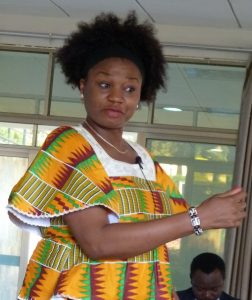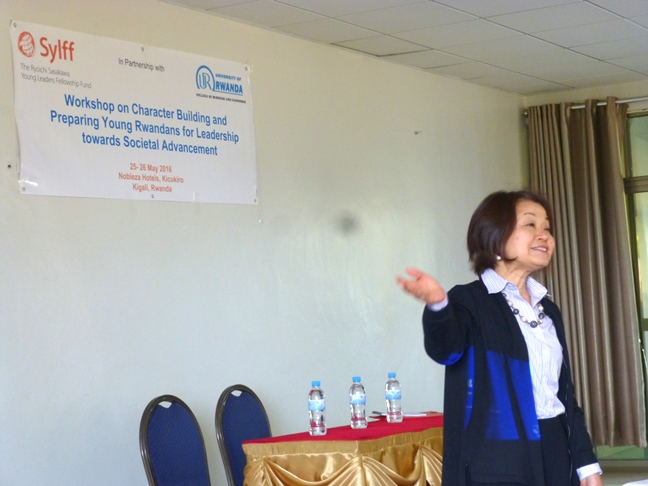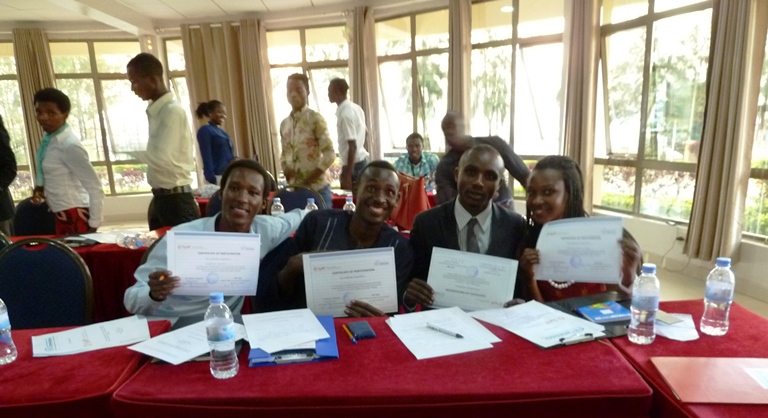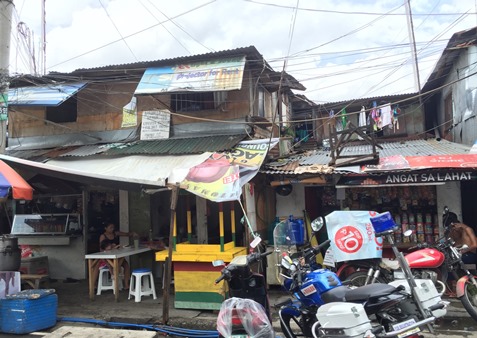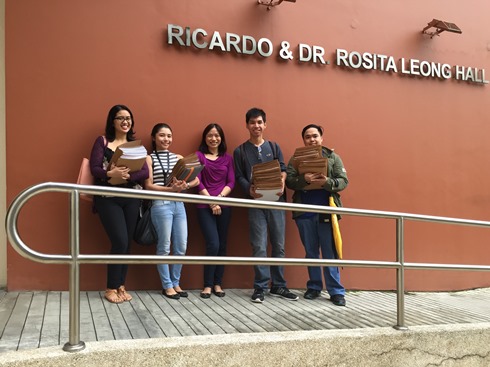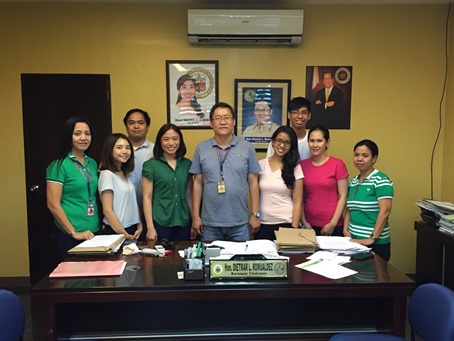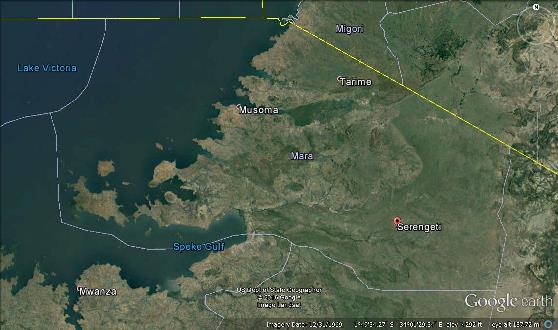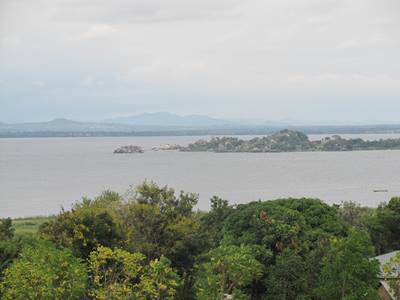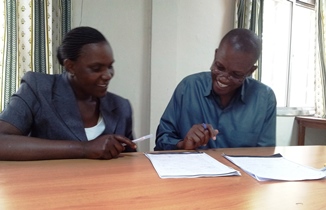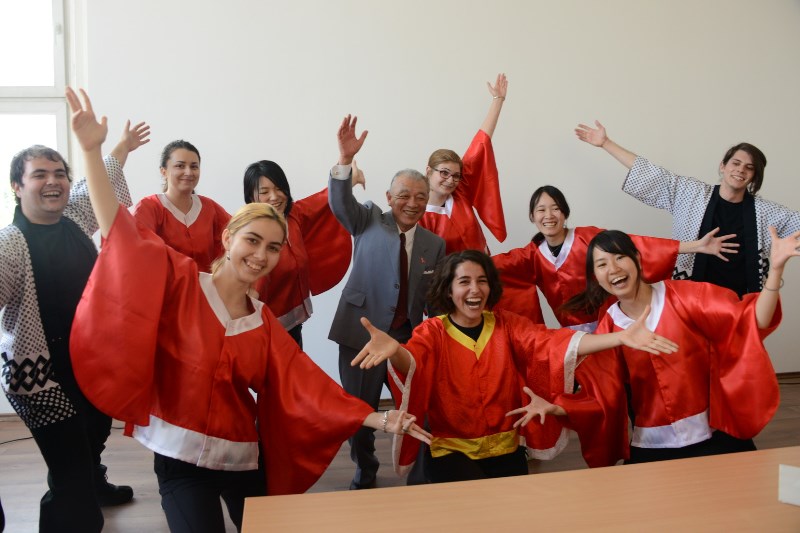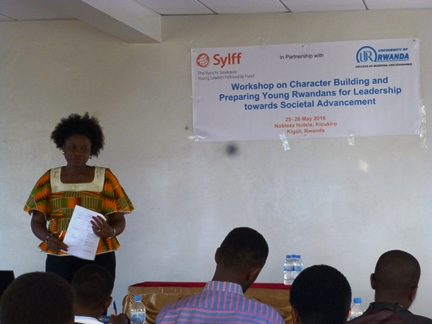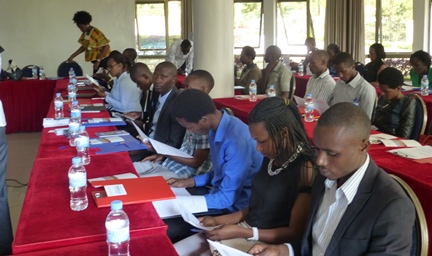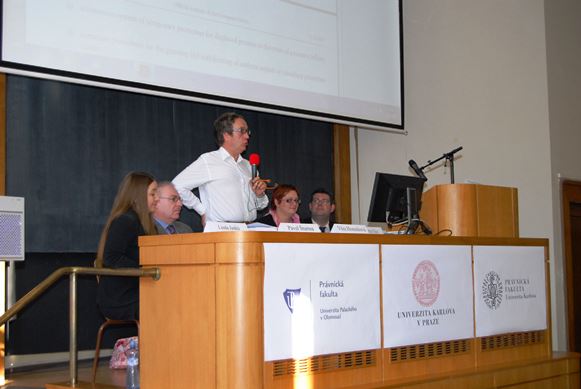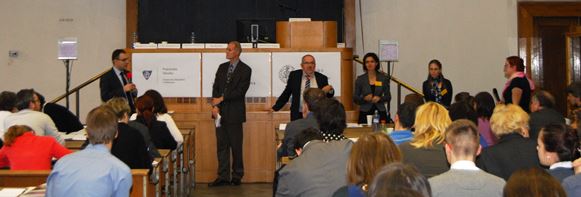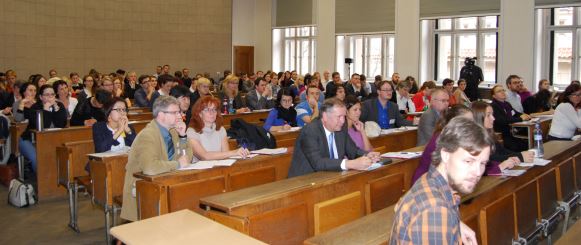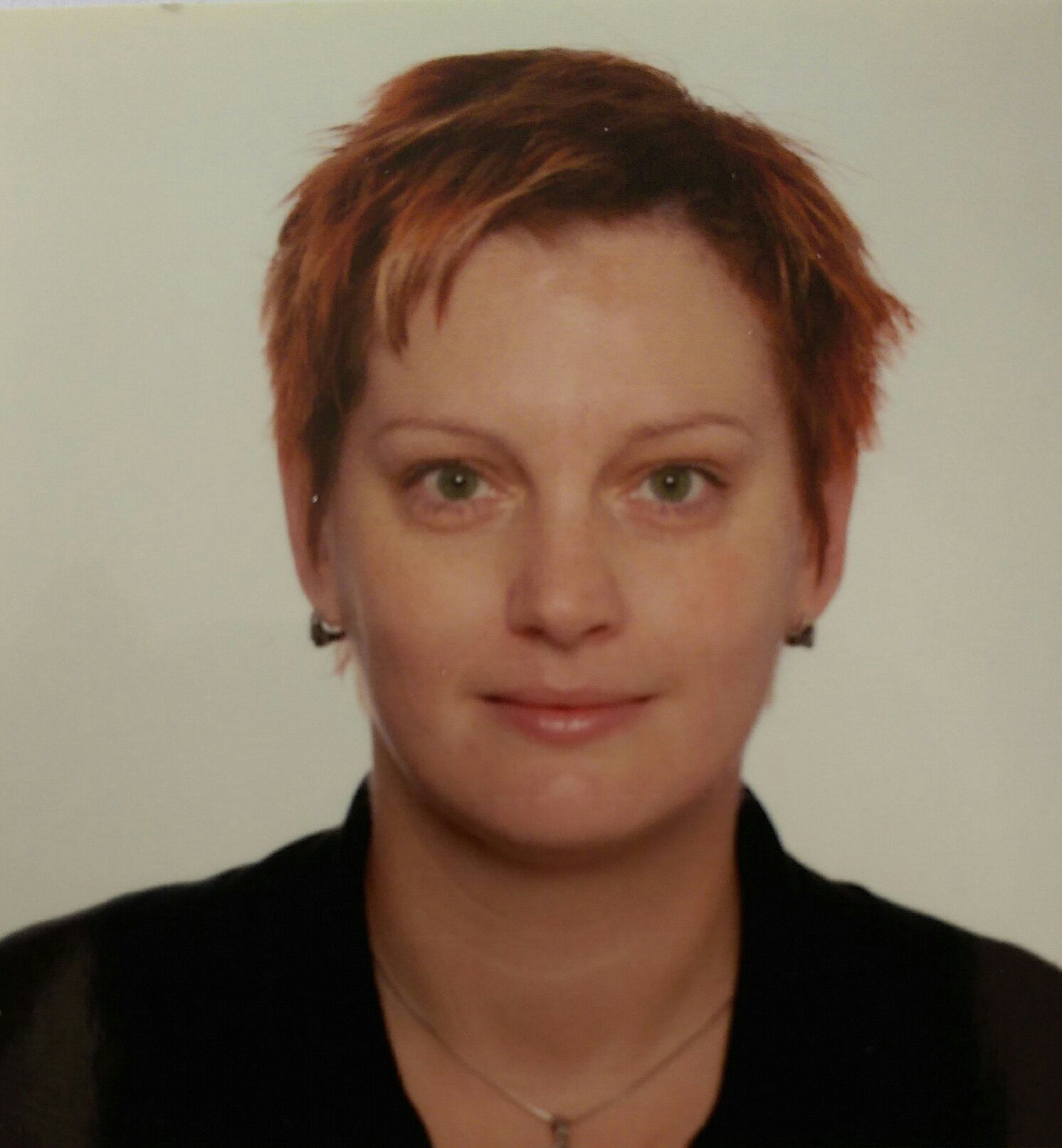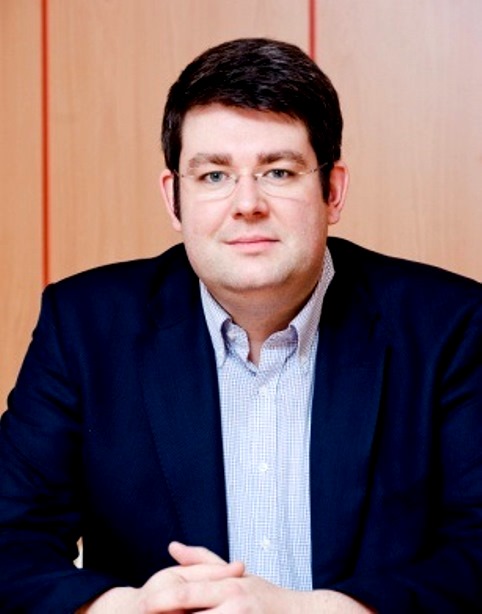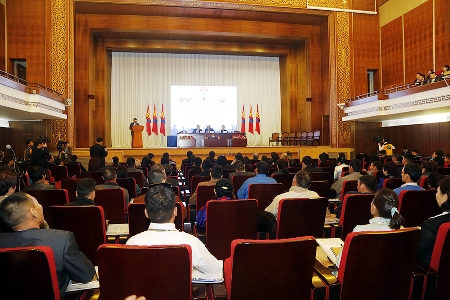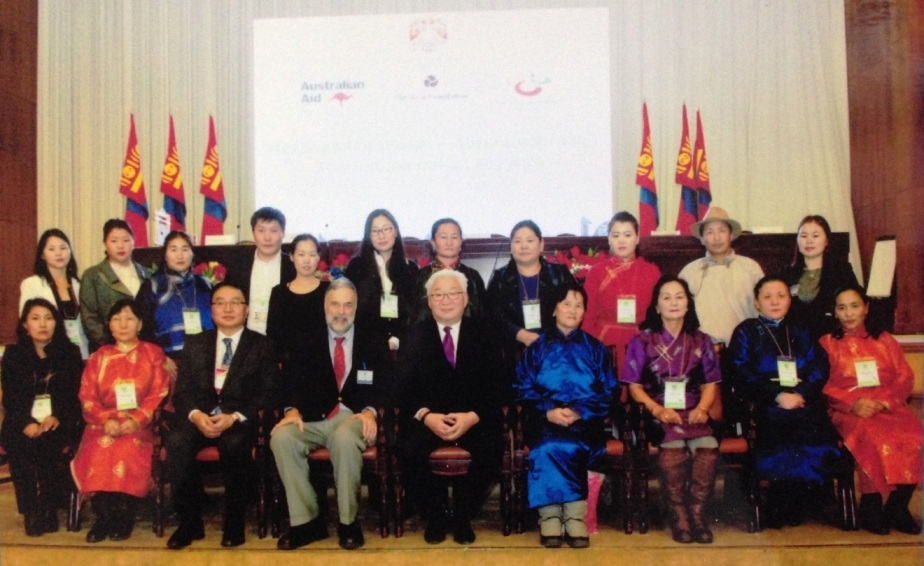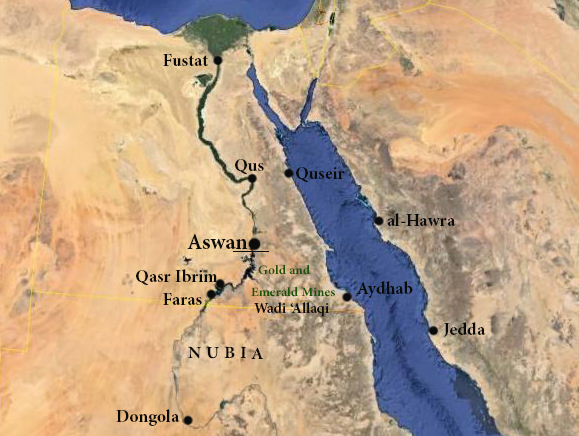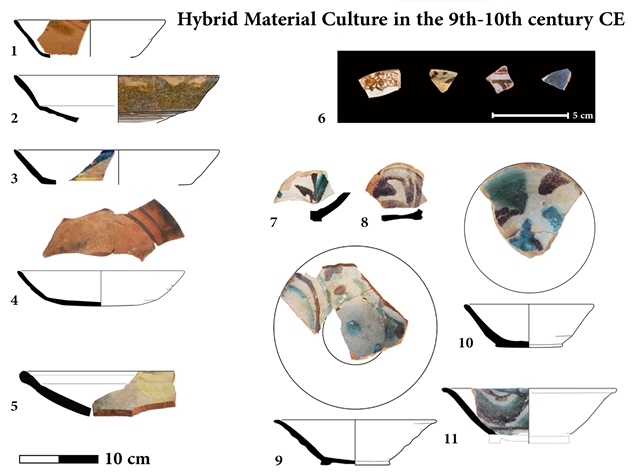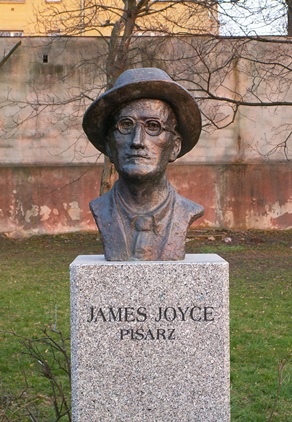Dipanwita Donde is a 2014–15 Sylff fellow from Jawaharlal Nehru University in India. Using an SRA award, she visited London and Dublin to see and study some of the original manuscripts of the Akbarnama, a beautiful illustrated book commissioned by a Mughal emperor. In this article, she explains how portraiture in the book is used to justify the sovereignty of the successors.
* * *
Abstract
In the closing years of the sixteenth century in India, there was an unexpected burst of portraits of medieval Indian men drawn from life that appeared in illustrated manuscripts, patronized by the third Mughal emperor1 Akbar (r. 1556–1605). The portraits included Turko-Mongol ancestors of Akbar who ruled in central Asia during the Timurid dynasty (1350–1507);2 Akbar’s immediate ancestors, Babur and Humayun;3 the men of Akbar’s court belonging to several different cultural and regional backgrounds;4 and Emperor Akbar himself. During Akbar’s reign, hundreds of thousands of folios were produced (for assembling into albums and manuscripts) in the imperial atelier by an estimated 100 artists working together as a team.5 The subjects explored in the manuscripts were primarily Persian texts authored by medieval poets such as Firdausi, Nizami, and Jami. Along with Persian epics, Akbar had the reigns of his ancestors written and compiled into histories, several copies of which he ordered to be produced into magnificent manuscripts. These illustrated manuscripts contained portrait images of Timurid and Mughal ancestors based on textual descriptions available in the writings of Timurid princes, including Babur,6 and made into stunning folios by the imperial artists. Akbar also ordered the history of his own reign to be chronicled, and Abul Fazl was chosen to write it. Abul Fazl took several years to complete it, finally presenting the Akbarnama (Book of Akbar) to the emperor in 1579.7 The text written by Abul Fazl was further produced into illustrated manuscripts, documenting pictorially the important episodes in the life and reign of Emperor Akbar.
In this paper, I raise three questions about the portrait of Akbar in the Akbarnama and attempt to answer them through my research.
1. What was the significance of portraiture during the reign of Emperor Akbar?
2. Which transcultural prototypes helped shape the portrait image of Emperor Akbar in the painted folios of the Akbarnama?
3. Were there any differences between the portrait of Akbar illustrated during his reign and posthumous images illustrated during the reign of his son and successor, Jahangir (r. 1605–1627)?
These questions are relevant to my research on the portrait of Akbar, which occupies a significant position in the genre of portraiture, explored extensively during the reign of Akbar and his successors. By raising these questions, I wish to trace how portraiture became a political tool for stating the ideology and sovereignty of Mughal emperors.
Significance of Portraiture in Mughal Manuscript Art
Portraiture—that is, images of persons drawn from life—was introduced into manuscript art8 in India during the reign of Emperor Akbar. The hundreds of portrait images of Akbar that were illustrated during his reign and during the reigns of his successors Jahangir (r. 1605–1627), Shah Jahan (r. 1628–58), and Aurangzeb (r. 1658–1707) signify a preoccupation with portraiture in manuscript art.
Akbar ascended the throne in 1556 at the age of 13, after the untimely death of his father, Humayun (r. 1530–40, 1555–56). Humayun had reconquered India in 1555 with the help of the Shia ruler of Iran, Shah Tahmasp (r. 1524–76). In addition to military support, Humayun had also requested the services of two painters from the Shah’s court to join him while he was in exile in Kabul. The two artists, Mir Sayyed Ali and Abd-ul Samad, joined Humayun’s camp at Kabul and accompanied him to India during his reconquest. Trained in Persian manuscript art, they were two of the finest artists in the court of the Shah, having displayed their brilliance in the several manuscripts produced during the reign of Shah Tahmasp. The artists brought with them a knowledge of Persian painting, which included portraiture learnt from the great master artist Bihzad (1450–1535) himself. Thus, the Persian iconographic canon that was in vogue in central Asia became the foundation of Mughal art, which originated during the reign of Emperor Akbar.
Soon after ascending the throne, Akbar launched a massive imperial manuscript art project, recruiting hundreds of artists from regional centers in the sub-continent. The two Persian artists who accompanied Akbar’s father to India became ustads (masters) under whom the Indian artists began illustrating episodes from Persian classics as well as the histories of the Timurid-Mughal dynasties. Under Akbar’s orders and his personal supervision, the histories of the reign of his ancestors as well as his own history were first documented textually and then illustrated into fabulous manuscripts, displaying the mature Akbari style.9 These illustrated histories carried portrait images of Akbar’s ancestors, some drawn posthumously, based on textual descriptions; some were copies of portraits of Babur and Humayun that had been drawn from life. Akbar also ordered portrait images of his courtiers to be drawn from life and assembled into an album for his perusal. He further showed keen interest in Sufis and Indian holy men living in his realm and ordered their portraits to be illustrated. These portraits of Timurid sultans, Mughal emperors, Rajput nobility, and other ordinary men displayed in the albums produced for Akbar, along with his own portraits represented in the Akbarnama, must have been the largest collection of portraits of medieval men in India in the sixteenth century.
My research, however, focuses on the portrait image of Akbar in the Akbarnama, tracing the different transcultural strains that were sourced and transferred from Persian, Indic, and European prototypes to shape the emperor’s portrait image.
Portraits of Akbar in the Akbarnama
During my research, I studied the portraits of Akbar in the Akbarnama published in art history books and read essays written by Mughal scholars about portraiture in Mughal art. I was deeply influenced by the writings of Dr. Susan Stronge, especially her essay in which she categorized the images of the emperor shown in one codex into different genres, which helped shape the personality of Emperor Akbar. Dr. Stronge further divided the illustrations into separate categories and placed groups of images under these subcategories. This exercise was very useful in that it enabled future scholars to study and compare the genres defined by Dr. Stronge.
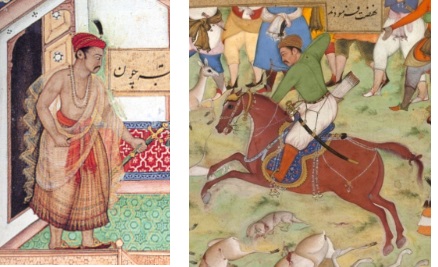
The portrait of Akbar, indexing his particular characteristics, was used like a stencil in multiple compositions.
Portraits of Akbar from the Victoria and Albert Museum’s Akbarnama
Mughal c. 1586–89
©Victoria and Albert Museum, London (visited January 14–30, 2016)
Dr. Stronge argued that the paintings fell under five identifiable categories: the royal hunt, the depiction of treachery, scenes of prestige, battles, and the life of the king.10 This categorization, however, limits any further study of Akbar’s portrait, as the imperial image is repeatedly represented without much variation to his form, despite occupying a prime location within carefully composed narratives. If we were to expand the concept of portraiture by including the emperor’s personality and attempt to trace prototypes that could have served as models, we should be able to identify ideologies and identities absorbed from transcultural sources that defined the portrait image of the emperor.
After studying the portrait images of Akbar illustrated in the Akbarnama, I realized that these categories needed further research. I questioned where these ideas originated from. In other words, were there any textual sources that informed the construction of Akbar’s personality in the Akbarnama?
My research led me to medieval Persian texts, imbued with tales of epic heroes and kings that were used as models for Timurid rulers of central Asia. The sultans of central Asia fashioned their biographies upon the lives and reigns of ancient heroes and kings narrated in Persian literature. Painted codices with portraits of Timurid sultans often had ruling sultans emulate figures of protagonists from ancient and medieval Persian texts.11 The circulation of these ideas in the wider Persian-speaking world during the 1500s ensured that all kings who conquered and ruled over local or foreign territories were informed by ideas of kingship from ancient classical and epic tales written by great poets of Persian literature. Hence, I was able to connect several pieces of texts composed during medieval times with images painted during the Mughal dynasty, in which, like their Timurid ancestors, the Mughal emperors displayed themselves as heroes of ancient and medieval epics. The image of Akbar, categorized into different genres within one codex, was an amalgamation of several transcultural prototypes drawn from Persian, Indic, and European sources.12
Two manuscripts of the original illustrated Akbarnamas, one illustrated in 1590–95 and the second painted in 1600–05, are now preserved in institutions outside India; the main bulk of the folios are preserved in the UK. Hence, I was very keen to avail myself of the Sylff Research Abroad fellowship to travel to the UK and study the original manuscripts.
Summary of Major Findings
The Sylff Research Abroad award allowed me to realize a dream: to see and study sixteenth-century Persian manuscript illustrations produced during the reign of Akbar in India. The original manuscripts of the Akbarnama, of which 116 illustrations are preserved at the Victoria and Albert Museum in London and 66 illustrations at the Chester Beatty Library in Dublin, Ireland, contain several minute details that can only be gauged with the naked eye. The fellowship allowed me to travel to the UK and research primary material. In addition, I met several scholars of Mughal art, who shared their knowledge with me and discussed what is being currently researched on the subject.
Along with the original folios of the Akbarnama, I studied more than 400 illustrations painted during the Mughal period that are preserved in the archives of the Victoria and Albert Museum, the British Library, and the Chester Beatty Library. I also researched Persian manuscripts illustrated during the Timurid and the Safavid periods in central Asia, which were the precursor to Mughal painting, and studied stylistic commonalities and differences between the Persian and Mughal manuscripts.
Directly accessing primary material containing portrait images of Emperor Akbar helped me analyze how the portrait of Akbar functioned differently for each emperor. For Akbar, his own portrait imitated the model of Hero-King, Just-Ruler, Prophet-King, and God-King from Persian, Indic, and European sources. During the reign of Jahangir, however, Akbar’s portrait image underwent changes to suit the role of a divine Mughal ancestor on which Jahangir chose to shape his own portrait image.
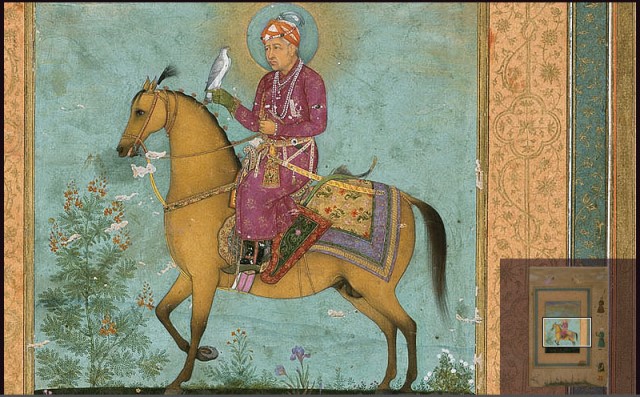
Akbar wearing a halo.
An Equestrian Portrait of Akbar
The Late Shah Jahan Album
c. 1650, India
In 07B.21b
The Chester Beatty Library (visited February 1–11, 2016)
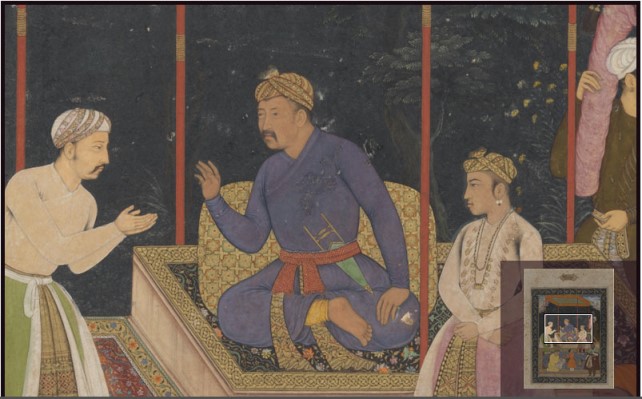
Akbar without a halo.
The Elderly Akbar Receives Murtaza Khan
Shuja' al-Dawla Album
Manohar
c. 1600, India, In 34.2
The Chester Beatty Library (visited February 1–11, 2016)
According to my research of the primary material preserved at the Chester Beatty Library and the Victoria and Albert Museum, functions of portraiture differed between father and son, due to three factors.
Firstly, the portrait image of Akbar developed during the emperor’s rule was carefully constructed to address a polity that would recognize and be familiar with the symbols of kingship that was in circulation. Thus, the portrait of Akbar as depicted in illustrated folios addressed his audience with the visual lexicon developed by his ancestors, the Timurids of central Asia. They relied heavily on Persian literary sources, which were in circulation throughout the Persian-speaking world.
Secondly, in the Persian tradition, the king had to display certain characteristics to project himself as a suitable ruler for his subjects. These characteristics were:
i) a great hero-king based on the personality of Rustam, the hero of Shahnama (Book of Kings) written by Firdausi in the tenth century;
ii) a humanist king based on Sufi literature developed by great poets like Jami writing in the Timurid courts during the fifteenth century;
iii) a prophet-king emulating the character of Iskander, Alexander the Great, in the Iskandernama (Romance of Alexander) written by Nizami in the twelfth century; and
iv) in Akbar’s case, a god-king based on Sanskrit texts that discussed several avatars of Lord Vishnu and considered the king, including a Muslim emperor like Akbar, to be an avatar of the Hindu god Vishnu.
Akbar’s personality as depicted in the Akbarnama displayed all these characteristics of an ideal ruler, gathered from several literary and transcultural sources.

Akbar as a brave hero(left), and Akbar as a just ruler(right).
Portraits of Akbar from the Victoria and Albert Museum’s Akbarnama
Mughal c. 1586–89
©Victoria and Albert Museum, London (visited January 14–30, 2016)
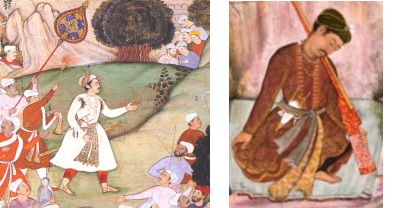
Akbar as a Sufi (left), and Akbar in a spiritual trance (right)
Portraits of Akbar from the Victoria and Albert Museum’s Akbarnama
Mughal c. 1586–89
©Victoria and Albert Museum, London (visited January 14–30, 2016)
Thirdly, when Akbar’s son and successor Jahangir ascended the throne, he needed to reimagine Akbar’s portrait to suit his own demand for an ancestral hero-king imbued with divine qualities. The reimagining of Akbar’s portrait was necessary to articulate an alternative politics that suited the newly announced emperor and help Jahangir project an image of himself as a world conqueror with divine attributes.
During my visit to the Chester Beatty Library in Dublin, I was able to match text with image, which helped me locate certain alterations in Akbar’s portraits13 that were illustrated during the reign of his son. This finding helps me prove my argument that the portrait image of Akbar was remapped by Jahangir to suit a dynastic-ancestral image to legitimize his own rule.
Transcultural Distinctiveness at Akbar’s Court
Illustrated manuscripts can tell us many aspects of human societies and how social relations were hinged upon a keen understanding between a ruler and his subjects. During the reign of Akbar in India, the emperor followed a structure of protocol that included systems taken from many cultural sources and applied universally at the royal court. This transcultural homogeneity was the most unique aspect of Akbar’s reign that transferred traditional courtly culture informed by Persianate tradition, as well as shaping a new courtly culture based upon systems absorbed from Hindu traditions.
The medium of portraiture, which formed the bulk of the images in Mughal art during the reigns of Akbar, Jahangir, and Shah Jahan, allows us a window by which we can not only study the physiognomic particularities of men belonging to a particular region, but also glimpse the popular models that were in vogue and which helped shape the portrait images of Mughal emperors, their coterie, and their subjects. Furthermore, by studying the changes in the visual lexicon between portraits of emperors depicted during their lifetimes and those re-created during the reigns of their successors, we can trace the politics and ideology articulated by the ruling emperor through the medium of manuscript art.
Bibliography
Beach, Milo C., B.N. Goswamy, et al, eds., Masters of Indian Painting, 1100–1900 (New York: Artibus Asiae Publishers, 2011)
Crill, Rosemary and Kapil Jariwala, eds., The Indian Portrait, 1560–1860 (Ahmedabad: Mapin Publishing, 2010)
Dimand, S. Maurice, “Mughal Painting under Akbar the Great,” Metropolitan Museum of Art Bulletin, New Series, vol. 10, no. 2 (1953), pp. 46–51
Eraly, Abraham, The Mughal World: Life in India’s Golden Age (New Delhi: Penguin Books India, 2007)
Koch, Ebba, Mughal Art and Imperial Ideology: Collected Essays (New Delhi: Oxford University Press, 2001)
Losty, J., The Art of the Book in India (London: The British Library Publishing Division, 1982)
Sims, Eleanor, Peerless Images: Persian Painting and Its Sources (Mapin Publishing in association with Yale University Press, 2002)
Soucek, Priscilla, “Persian Artists in Mughal India: Influences and Transformations,” Muqarnas, vol. 4 (1987), pp. 166–181
1The Mughals were the descendants of Turko-Mongol sultans of the Timurid dynasty who ruled in central Asia from the fourteenth to sixteenth centuries. The Mughals ruled in India from 1526, when Babur defeated the Lodhis and established the empire. The last emperor of the Mughal dynasty was Bahadur Shah II, who was exiled by the British empire in 1857.
2The Timurid dynasty began in 1370 under the reign of Shah Timur (r. 1370–1407) in central Asia. The Timurid princes were great patrons of Persian literature and patronized several brilliantly illustrated manuscripts during their reigns. Beatrice Forbes Manz notes that the cultural revival that began under Shahrukh (r. 1405–1447) reached its zenith under Sultan Husayn Bayqara (r. 1470–1506), who turned Herat into a “shining centre of cultural patronage” (Manz, “Temür and the Problem of a Conqueror's Legacy,” Journal of the Royal Asiatic Society, vol. 8, iss. 1 [1998], p. 39). Also see Thomas W. Lentz and Glenn D. Lowry, Timur and the Princely Vision: Persian Art and Culture in the Fifteenth Century (Los Angeles: Museum Associates, Los Angeles County Museum of Art, 1989) and Beatrice Forbes Manz, “Tamerlane’s Career and Its Uses,” Journal of World History, vol. 13, no. 1 (2002), pp. 1–25.
3Babur was the first Mughal emperor in India. He conquered India in 1526 and reigned there until his death in 1530. Humayun, Babur’s son and successor, ruled India in 1531–40 and again in 1555–56.
4The men of Akbar’s court were Persian, Uzbeks, Afghans, Jesuits, and Rajputs belonging to Shia, Sunni, Christian, and Hindu faiths.
5Milo Cleveland Beach, The Imperial Image: Paintings for the Mughal Court (Washington, DC: Freer Gallery of Art, Smithsonian Institution, 1981), p. 19.
6Babur was the author of Baburnama, the first autobiography written by a Timurid prince.
7The official history of Akbar’s reign was begun in 1589 and completed in 1598, in the fifth and final decade of Akbar’s rule.
8Manuscript art, also known as miniature painting, originated in Persia during the reign of Mongol conquerors in the fourteenth century. Illustrations made on paper were accompanied by Persian calligraphy written in text boxes within the composition. They were usually assembled into albums and bound with a leather cover, decorated with gold inscriptions and intricate designs.
9J. Losty, The Art of the Book in India (London: The British Library Publishing Division, 1982).
10Susan Stronge, Painting for the Mughal Emperor: The Art of the Book, 1560–1660 (London: Victoria and Albert Museum, 2002), pp. 68–84.
11See Eleanor Sims, “The Illustrated Manuscripts of Firdausī’s Shāhnamā Commissioned by Princes of the House of Tīmūr,” Ars Orientalis, vol. 22 (1992), pp. 43–68. Discussing three illustrated manuscripts of the Shahnama produced for the three Timurid princes—Ibrahim Sultan (1435), Baysangur (1433), and Mohammad Juki (1444)—Sims notes that each contains at least one illustration that could be interpreted as a “portrait” of the prince who commissioned it (p. 44); as cited in Linda T. Darling, “’Do Justice, Do Justice, For That is Paradise’: Middle Eastern Advice for Muslim Rulers in India,” Comparative Studies of South Asia, Africa and the Middle East, vol. 22, nos. 1 and 2 (2002).
12See Catherine Asher, “Ray from the Sun: Mughal Ideology and the Visual Construction of the Divine,” in The Presence of Light: Divine Radiance and Religious Experience, ed. Matthew T. Kapstein (Chicago: University of Chicago Press, 2004); Milo C. Beach, The Imperial Image: Paintings for the Mughal Court; and A. Azfar Moin, The Millennial Sovereign: Sacred Kingship and Sainthood in Islam (New York: Columbia University Press, 2012).
13The use of the halo, a heavily jeweled Emperor Akbar, an older monarch than seen imaged in the first Akbarnama with gray hair and a slightly stooped body—these were some of the alterations in Akbar’s image made during the reign of Jahangir.

